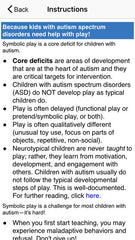Teaching Play in 9 Crucial Steps.
Play is vital to development, make sure your child knows how!
To children on the spectrum, the words “go out and play!” can cause downright confusion. Yet play is not only fun, it is vital to physical and psychological development. So how do you teach an activity that is seemingly as automatic as breathing? With a plan,of course. Our partners, Stephanny Freeman and Kristen Hayashida have created a new app—Play Idea Cards—a step-by-step process for teaching children with ASD to play, based on these 9 key steps to success:
- Teach at the Appropriate Level
We humans are aspirational creatures—we naturally strive for improvement. So while it is important not to teach at too high a level, it is just as important not to teach too low. Always try to teach play at a level just ABOVE your child’s current abilities
- Set up the Environment
Organize, organize, organize! It will help your child progress steadily and calmly. Categorize your toys by type: figures, animals, train, etc. and make sure the toys just above your child’s current abilities are right at eye level. Play is a skill, just like anything else, and a well-organized environment is key.

- Allow Your Child to Initiate Their Interests
Your job is to facilitate, not dictate—ask your child “What should we play with?” and let him/her pick. You can prompt them if they are unsure (more about this later) but let them drive the session. And make sure you’re excited about their choice!
- Prompt
Even though your child is in the driver’s seat, you are still the navigator. Do not let your child get away from you. Early prompts should be suggestive, but if your child wanders, it is key to politely bring them back and complete the task. The Play Idea Cards app has an entire prompt hierarchy to help with this.
- Develop Routines
Just like organization, a set routine helps calm your child and let him/her focus on the task at hand—playing. Create a predictable sequence of acts or events.
Setting up the routine is great, but maintaining it while allowing for progress is a must. Enjoy the established routine, but then explore and violate. Surprise your child by occasionally doing something unexpected.

Like choosing play levels, choose language that matches your child’s development level. Make sure to narrate what your child is focused on AND what you are doing.
8. Praise
Everyone loves a pat on the back. So don’t be stingy with your praise, but do be specific. “Wow, you put the baby to bed!” is far better than “Good job!”
- Generalize
By this we mean make sure your child masters a play activity, adding to the play scenario rather than simply imitating you. Play is generalized when your child can vary the toy they use, the people they play with or the place they play.
Teaching play is just like teaching math—you need a plan, a goal, and a little humor never hurts!
Our new app—Play Idea Cards is an entire play curriculum, right in the palm of your hand. Get in-depth teaching tools, aids and tips based on the 9 components we’ve laid out above. 150 flash cards, across 14 play levels, help bring things to life, and each card has its own teaching plan and prompts, so you are never alone. Bookmark cards, rearrange them to meet your particular needs, leave yourself voice notes to remind you what works. This is one powerful tool for the all-important job of teaching play. Find Autism: Teaching Play in the App Store!

